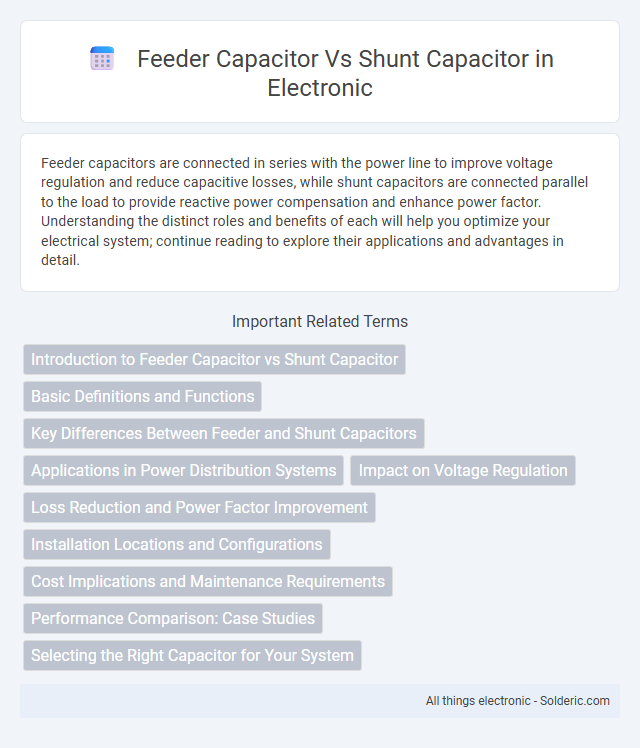Feeder capacitors are connected in series with the power line to improve voltage regulation and reduce capacitive losses, while shunt capacitors are connected parallel to the load to provide reactive power compensation and enhance power factor. Understanding the distinct roles and benefits of each will help you optimize your electrical system; continue reading to explore their applications and advantages in detail.
Comparison Table
| Feature | Feeder Capacitor | Shunt Capacitor |
|---|---|---|
| Purpose | Supports voltage regulation along transmission feeders | Improves power factor at load or distribution level |
| Connection Type | Series or near series with feeder line | Connected in parallel (shunt) to the load |
| Main Function | Reduces voltage drop and improves voltage profile | Compensates reactive power and reduces losses |
| Installation Location | Along transmission or distribution feeders | At load centers or distribution transformers |
| Effect on System | Enhances voltage stability on feeder lines | Improves power factor and reduces demand charges |
| Typical Usage | Long feeders with significant voltage drop issues | Industrial, commercial, and residential load compensation |
Introduction to Feeder Capacitor vs Shunt Capacitor
Feeder capacitors are installed along distribution feeders to improve power factor and voltage stability by supplying reactive power closer to the load, reducing losses and voltage drops. Shunt capacitors connect in parallel with the load at distribution substations or customer sites, primarily to provide localized reactive power support and improve system efficiency. Understanding your power system's configuration helps determine whether feeder or shunt capacitors offer the best solution for voltage regulation and energy savings.
Basic Definitions and Functions
Feeder capacitors are installed along distribution lines to improve voltage stability and reduce power losses by providing reactive power compensation directly in the feeder network. Shunt capacitors are connected parallel to the load to supply reactive power locally, enhancing power factor and reducing the current drawn from the source. Choosing the right capacitor depends on whether your goal is to improve voltage profile along the feeder or to offset local reactive power demand.
Key Differences Between Feeder and Shunt Capacitors
Feeder capacitors are installed along transmission or distribution lines to improve voltage profiles and reduce line losses, while shunt capacitors are connected in parallel with the load to provide reactive power support and improve power factor. The main difference lies in their placement and primary function: feeder capacitors enhance voltage regulation over a distance, whereas shunt capacitors directly compensate reactive power at the load point. Your choice depends on system needs--feeder capacitors for line voltage stability and shunt capacitors for load power factor correction.
Applications in Power Distribution Systems
Feeder capacitors are installed along distribution feeders to improve voltage profiles, reduce line losses, and support load growth by injecting reactive power locally. Shunt capacitors, typically placed near load centers or substations, provide reactive power compensation, voltage regulation, and enhance power factor correction in power distribution systems. Your choice between feeder and shunt capacitors depends on the specific load conditions and system design requirements to optimize efficiency and voltage stability.
Impact on Voltage Regulation
Feeder capacitors improve voltage regulation by compensating for voltage drops along distribution lines, enhancing the voltage profile at downstream nodes and reducing losses. Shunt capacitors, connected at load points, provide local reactive power support, stabilizing voltage levels and minimizing fluctuations within the distribution network. Effective implementation of feeder and shunt capacitors boosts overall power system efficiency and voltage stability.
Loss Reduction and Power Factor Improvement
Feeder capacitors reduce losses by compensating reactive power closer to the load, minimizing current flow and voltage drops along transmission lines. Shunt capacitors improve power factor by supplying reactive power directly at the distribution bus, enhancing voltage stability and reducing the need for additional generation. Your system benefits most when feeder capacitors are used for loss reduction, while shunt capacitors primarily target power factor correction.
Installation Locations and Configurations
Feeder capacitors are installed directly on distribution feeders to provide voltage support along specific lines, optimizing power factor and reducing line losses over extended distances. Shunt capacitors are typically placed near load centers or at busbars within substations to supply reactive power locally, stabilizing voltage and improving system efficiency. Your choice between these configurations depends on the targeted area of voltage correction and the desired impact on system stability and loss reduction.
Cost Implications and Maintenance Requirements
Feeder capacitors typically involve higher initial costs due to their larger size and placement along distribution feeders, requiring more robust infrastructure and complex installation processes. Shunt capacitors, installed near load points, often have lower upfront expenses and simpler maintenance routines, benefiting from easier accessibility and standardized designs. Maintenance for feeder capacitors demands specialized equipment and longer downtime, whereas shunt capacitors allow quicker inspections and replacements, reducing operational costs over time.
Performance Comparison: Case Studies
Feeder capacitors improve voltage profile and reduce line losses by providing reactive power directly along distribution feeders, as demonstrated in case studies from urban networks showing enhanced loadability and stability. Shunt capacitors, installed at substations or load points, effectively correct power factor and reduce demand charges, with documented cases highlighting decreased energy costs and improved transformer efficiency. Comparative analyses reveal feeder capacitors excel in voltage regulation under variable load conditions, while shunt capacitors offer superior benefits in controlling system-wide reactive power and minimizing feeder current distortion.
Selecting the Right Capacitor for Your System
Feeder capacitors are installed along distribution lines to improve voltage stability and reduce losses over long distances, making them ideal for maintaining power quality in extended feeder networks. Shunt capacitors connect directly at load points to provide local reactive power compensation, enhancing voltage regulation and reducing demand on the upstream system. Selecting the right capacitor for your system depends on factors such as load configuration, distance from the source, and the need for localized voltage support or overall line power factor correction.
feeder capacitor vs shunt capacitor Infographic

 solderic.com
solderic.com